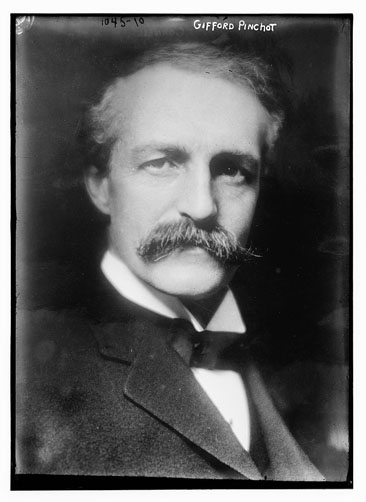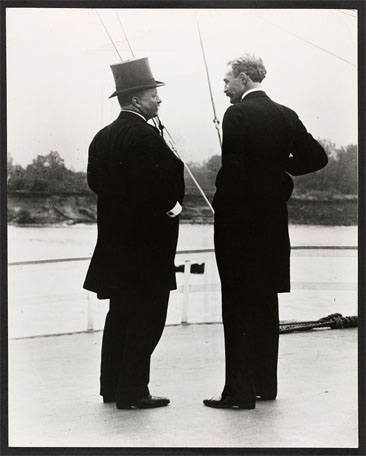11 Aug. 1865–4 Oct. 1946
See also: Biltmore Forest School

Gifford Pinchot, forester and politician, was born in Simsbury, Conn., the eldest son of James W. and Mary Jane Eno Pinchot. James was a wealthy manufacturer and partner in the firm, Pinchot, Warren and Company in New York City. One of four children, Pinchot was named after Sanford Gifford, a noted American landscape painter. He was raised in Milford, Pa., his father's birthplace. In 1885, the year after his graduation from Phillips Exeter Academy in New Hampshire, he entered Yale College, where he studied botany, geology, and meteorology; he was graduated in 1889. Pinchot developed an interest in forestry and went to London to study with Sir Dietrich Brandis, the leading forester of the day. At this time there was no organized school of forestry in the United States. Brandis sent Pinchot to the French Forestry School at Nancy, where he studied silviculture and forest economics in 1889–90. He became the first American to choose forestry as a profession.
In the 1890s George W. Vanderbilt began purchasing large tracts of land in the North Carolina mountains for the construction of his residence, Biltmore House. At the suggestion of his landscape architect, Frederick Law Olmsted, Vanderbilt hired Pinchot, America's first trained forester, to devise a plan for managing Biltmore Forest and to prepare an exhibition of the forest for the World's Columbian Exposition in Chicago. Upon his arrival at Biltmore on 2 Feb. 1892, Pinchot found the forest in poor condition after many years of neglect. Although his forest management was subject only to Vanderbilt's control, Pinchot's work was affected by the purpose of the estate as a residence. He and Vanderbilt established three goals for this pioneering work: to promote the profitable production of timber, to establish a constant annual yield, and to improve the general condition of the forest.
In order to do an efficient job, Pinchot made an extensive topographical survey of the estate. He divided the forest into ninety-two units of forty-two acres each. These tracts were examined and relevant silvicultural data were entered into a card catalogue. Pinchot began his forest enhancement by making improvement cuttings. Although sure of the scientific and educational advantages of careful timber cuttings, he doubted that the lumber produced by this method could compete with that provided by traditional lumbering techniques. However, Pinchot was fortunate in finding a good market for cordwood and sawed lumber and thus had a favorable financial balance in his first year. Along with a successful exhibition and a pamphlet prepared for the World's Columbian Exposition in 1893, Pinchot drew considerable publicity to the advantages of practical scientific forestry in America.
In 1894 Pinchot discovered the Pink Beds, a three-thousand-acre valley of rhododendron and mountain laurel in nearby Transylvania County. At his recommendation, Vanderbilt purchased this land and consolidated it with other tracts to create the Pisgah Forest. Pinchot remained at Biltmore until 1895, when he suggested that Vanderbilt hire Carl A. Schenck as resident forester. Schenck, a German forester, established the Biltmore Forest School, the first school of forestry in the United States.
Pinchot worked as a forestry consultant throughout the country. In 1897 he took a post with the U.S. Forest Service to make a survey of U.S. forest reserves. As part of his report, Pinchot suggested that a government forest service be established to protect and control forest reserves. In 1898 he accepted an appointment as head of the U.S. Forest Service with the title of forester, an office located in the Department of Agriculture.

During the Theodore Roosevelt administration, Pinchot moved control of U.S. forests to the Bureau of Forestry. Roosevelt strongly supported Pinchot's conservationist measures, as the two became very close friends. However, William Howard Taft, Roosevelt's successor, did not hold the same views. Days before Taft's inauguration, Roosevelt, Pinchot, and James Garfield, secretary of the interior, withdrew some four million acres of public lands from private use. Under Taft, Garfield was succeeded by Ralph Ballinger, a rival of Pinchot. Although Ballinger was not an anticonservationist, his ideas were very different from Pinchot's strict views. Pinchot accused Ballinger of trying to give government lands to the power trust. In the dispute Taft sided with Ballinger and fired Pinchot on 7 Jan. 1910 for disrespect to the president and official insubordination.
Pinchot returned to the private sector as a forestry consultant. On 15 Aug. 1914 he married Cornelia Bryce at Roslyn, Long Island, the bride's home. Theodore Roosevelt attended the wedding. At this time, Pinchot became extremely interested in politics. In 1914 he ran for the U.S. Senate as a Progressive but was defeated by Boies Penrose. Pinchot left the Progressives to become a Republican. In March 1918 he became Pennsylvania state forestry commissioner under Governor William Sproul. In 1922 Pinchot was elected governor of Pennsylvania and served from 1923 to 1927. In the fall of 1923 he was a candidate for one of the statewide delegates to the 1924 presidential nominating convention. As governor, he felt confident and did not campaign. But due to his criticism of the national administration, Pinchot lost support in the urban areas and was defeated by Ralph B. Strassburger.
Pinchot ran unsuccessfully in the 1926 Republican primary for the U.S. Senate. Again, he showed strength in the rural areas but was soundly defeated in urban centers, such as Philadelphia. In 1930 Pinchot was elected governor of Pennsylvania for a second time and served in the period 1931–35. He did not align himself with the regular party organization when he ran for the U.S. Senate for a third time in 1934. The Republican party saw Pinchot as an enemy of industry and not a Republican at heart. He was defeated in the primary by incumbent David Reed. Pinchot was virtually a man without a party; however, he continued to voice his choice of candidates.
During the last ten years of his life, Pinchot fought every action against forestry and conservation. He was a consultant to Franklin D. Roosevelt and Harry S Truman. In 1935 he began an autobiography that covered the years until his dismissal from the U.S. Forest Service in 1910. After ten years of hard work, he finished one day before his eightieth birthday. Breaking New Ground, a defense of Pinchot's views on forestry and his side of the Ballinger controversy, was published posthumously in 1947.
Following the funeral on the lawn of his home, Grey Towers, Pinchot was buried in Milford Cemetery, Milford, Pa. He was survived by his only son, Gifford Bryce Pinchot (b. 22 Dec. 1915). The state of Pennsylvania never erected a statue of Governor Pinchot but more appropriately dedicated a two-thousand-acre state park in his name. Similarly, the Sierra Club dedicated a large redwood tree located in California's Muir Woods to Gifford Pinchot, a longtime advocate of conservation.